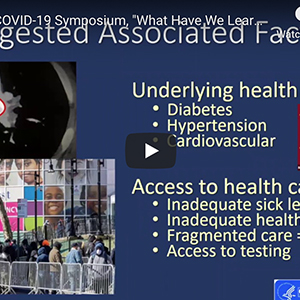NYMC and TCUS Host Fourth COVID-19 Symposium
"What Have We Learned? How Can We Use What We Have Learned?"

Having established itself as one of the State’s leading thought leaders on the COVID-19 health crisis, the Center for Disaster Medicine (CDM) at New York Medical College (NYMC) and the Touro College and University System (TCUS) presented the fourth COVID-19 Symposium, "What Have We Learned? How Can We Use What We Have Learned?," via a webinar on June 18. Moderated by Edward C. Halperin, M.D., M.A., chancellor and chief executive officer at NYMC, the event brought together a panel of experts to share lessons learned during the pandemic and insight into the future of the COVID-19 crisis.
Robert Amler, M.D., M.B.A., dean of the School of Health Sciences and Practice and vice president of government affairs, who was tapped for the symposium to speak about why minorities are hit so hard by COVID-19, discussed some of the possible associated factors including living conditions, work circumstances, underlying health conditions, transportation, access to health care and systemic inequities. “The pathway to improvement equals “Public Health 101,” basic public health strategies that are tried and true,” he said. Dr. Amler shared the importance of health promotion with full participation and partnerships, engagement with thought leaders and improved surveillance investigation and response.
Jerry L. Nadler, M.D., MACP, FAHA, FACE, dean of the School of Medicine, professor of medicine and pharmacology, spoke on his area of expertise and discussed the higher rates of mortality and morbidity of COVID-19 on diabetics and the mechanisms for increased risk. “It is very important for people with diabetes to follow all updated guidelines for nutrition, physical activity, glucose monitoring and pharmacologic management to remain in good health,” Dr. Nadler emphasized.
Next, Janet Piscitelli, M.D., director of pathology and laboratory services at Westchester Medical Center Health Network discussed the confusion about laboratory testing for the COVID-19 pandemic and the SARS-CoV-2 virus responsible for it, as well as the continuously changing thoughts on diagnosis, surveillance and exposure. Dr. Piscitelli discussed the Centers for Disease Control and Prevention (CDC) recommendation for pooled testing, combining samples from people into one pool and testing the pool instead of individual samples. This method is only optimal when the prevalence of the virus is low, samples can be collected at one time and the population can be tracked using information technology. Pooled testing conserves valuable laboratory resources including reagents and labor.
Ronnie Myers, D.D.S., M.S., dean of the Touro College of Dental Medicine at New York Medical College presented his thoughts on visiting the dentist during the pandemic. He gave a historical perspective on infection prevention and safety in dentistry and how to best mitigate risk, especially for dentists who are at most risk for aerosol exposure in the dental environment. He shared what a dental visit will look like including teledentistry, symptom screening, masking and hand sanitizing, a socially distant waiting room with no reading materials or direct seating to the operatory, additional personal protective equipment, new disinfection protocols, longer turnaround time between patients and follow up appointments made virtually after the patient has left the office. Although it is safe to return to the dentist, Dr. Myers urged people to consider their dental and medical history, age and co-morbidities when deciding.
An update on the Coronavirus vaccine was presented by Robert W. Rubin, Ph.D., president and chief executive officer of Lovelace Biomedical in Albuquerque, New Mexico. He described the challenges of the different categories of vaccines including mRNA, vector and direct antigen, currently being developed by various companies and the issues of toxicity, hyper-immunogenicity, the number of subjects required for clinical trials and herd immunity. Most vaccines will likely require a booster, making production a concern, according to Dr. Rubin. He also discussed the treatments of Remdesivir, an effective but costly treatment and the future of direct antibody treatments.
Dr. Halperin then moderated a question and answer session with John T. Pellicone, M.D., FACP, FCCP, FAACVPR, chief medical officer, NYC Health & Hospitals/Metropolitan and assistant professor of medicine, and Renee Garrick, M.D., vice dean and chief medical officer, Westchester Medical Center and professor of clinical medicine, who shared lessons learned during the pandemic that will be useful if there is a second wave this year.
“One of the most important things we learned was the importance of having the flexibility to expand critical care and ICU services. We were able to that by converting a PACU to a makeshift ICU and we were ready to change our on-call floor to make them workable ICU rooms in a very short period of time,” Dr. Pellicone said. “The flexibility to convert rooms and fill them with appropriate staff was one of the most important lessons learned.”
According to Dr. Garrick planning, careful communication and the ability to be flexible and nimble were key lessons learned. “We re-staffed the ICUs by taking the surgical and anesthesia staff to create COVID teams,” she explained. “We essentially staffed two hospitals—a COVID-positive hospital and the ambulatory care pavilion which was a COVID-free hospital.”
Dr. Kadish concluded the symposium saying, “The bottom line is I am very concerned about what is going to happen over the next 12 to 18 months, but I am optimistic that we learned a tremendous amount since January 29, when the New York Medical College Center for Disaster Medicine hosted its first COVID-19 seminar. I am hopeful that as time goes forward, the knowledge that we gained from basic science and epidemiologic and clinical work moves forward in getting us closer to a solution to this pandemic and getting life back as close to normal as we can.”
